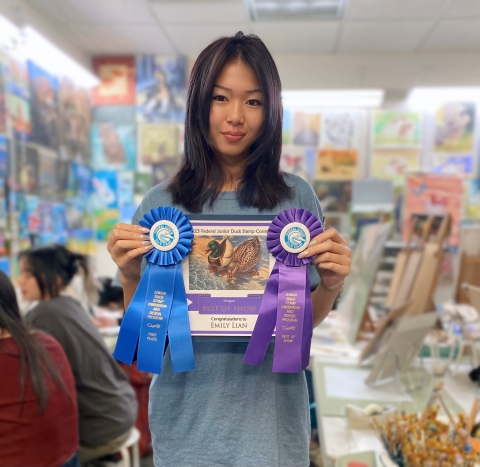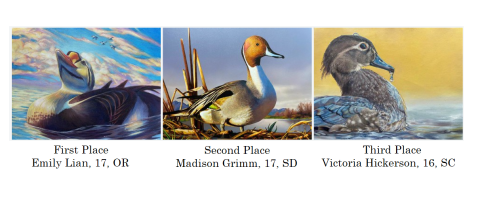Emily Lian said the key to her victory in winning top honors in the 2024 National Junior Duck Stamp Art Contest was perseverance.
The 17-year-old Portland, Oregon, artist – the state’s first to claim the distinction – said her journey with the U.S. Fish and Wildlife Service program began almost a decade ago. Over the years, she won local and state awards before scoring bigger victories.
“You really have to persevere,” Lian said. “You should not do art just to win, but to improve your skills gradually over time. As with anything, the practice and time you put into it will always be worth it, even if you aren’t rewarded immediately.”
The federal Junior Duck Stamp Conservation and Design Program began in 1989 as an extension of the Migratory Bird Hunting and Conservation Stamp, commonly known as the Duck Stamp. The first National Junior Duck Stamp Art Contest was held in 1993.
Nanette Seto, chief of the Migratory Birds and Habitat Program for the U.S. Fish and Wildlife Service’s Pacific Region, explained the environmental education program is available for school-age children from kindergarten through 12th grade in every state. About 3,000 Junior Duck Stamps are sold annually for $5 each.
“When people buy the Junior Duck Stamp, it doesn’t go into a pot of money that goes back into protecting wetlands,” Seto said. “This goes back into the program to build it and educate more kids.”
Lian’s art teacher, Xiao Hong (Shirley) Xu, has included the Junior Duck Stamp program in her curriculum at Sun Century Art Academy since 2006. “It offers a unique opportunity for students to learn about wildlife conservation and our responsibility to protect the environment,” she said.
Xiao said the program plays an important role in helping young artists develop their talent. “It fosters a sense of accomplishment, confidence and understanding of the importance of preserving natural habitats. Through years of participation, many of our students can identify more than 50 different species of ducks, and their parents often become knowledgeable about waterfowl.
“It helps them develop a deeper appreciation for wildlife and the environment and valuable skills in observing habitats, exercising patience in painting details such as feathers and water ripples, problem solving when facing frustration in the design process and expressing themselves artistically through color schemes and composition planning,” Xiao said.
Lian said she selected the king eider because of the unique shape of its head and its vibrant colors. Because it was her senior year in high school and final year in the contest, she wanted to try something bold.
“I decided I should do a confident, assertive and majestic pose. I just love to do art from an interesting perspective or framing to it,” she said.
“It’s not quite surrealistic, but not realist. That perspective was hard to do because it was hard to find images from that angle.”
Lian said taking top honors was a shock.
“Last year, I got third nationally for a painting of mallards. I was already super happy with that. I thought I was already peaking,” Lian said with a laugh.
Xiao said she didn’t share Lian’s shock. “I was thrilled when Emily’s painting was recognized as a top honor. I wasn’t entirely surprised, though. Her talent and dedication have always stood out. It was only a matter of time before her hard work was recognized on such a prestigious platform.”
By Jan Peterson, for the U.S. Fish and Wildlife Service
America loves its wildlife, both domestic and international, and that love of wild things and wild places helps define our character as a nation. The Service and its state partners face mounting pressures to conserve the species we are entrusted to manage from threats such as habitat loss, climate change climate change
Climate change includes both global warming driven by human-induced emissions of greenhouse gases and the resulting large-scale shifts in weather patterns. Though there have been previous periods of climatic change, since the mid-20th century humans have had an unprecedented impact on Earth's climate system and caused change on a global scale.
Learn more about climate change , wildlife disease and invasive species invasive species
An invasive species is any plant or animal that has spread or been introduced into a new area where they are, or could, cause harm to the environment, economy, or human, animal, or plant health. Their unwelcome presence can destroy ecosystems and cost millions of dollars.
Learn more about invasive species . Urgent action now can help the American people heal, minimize species decline, avert catastrophic invasive species takeover, build a more climate-resilient future, and address systemic exclusion of underrepresented people in wildlife conservation.






